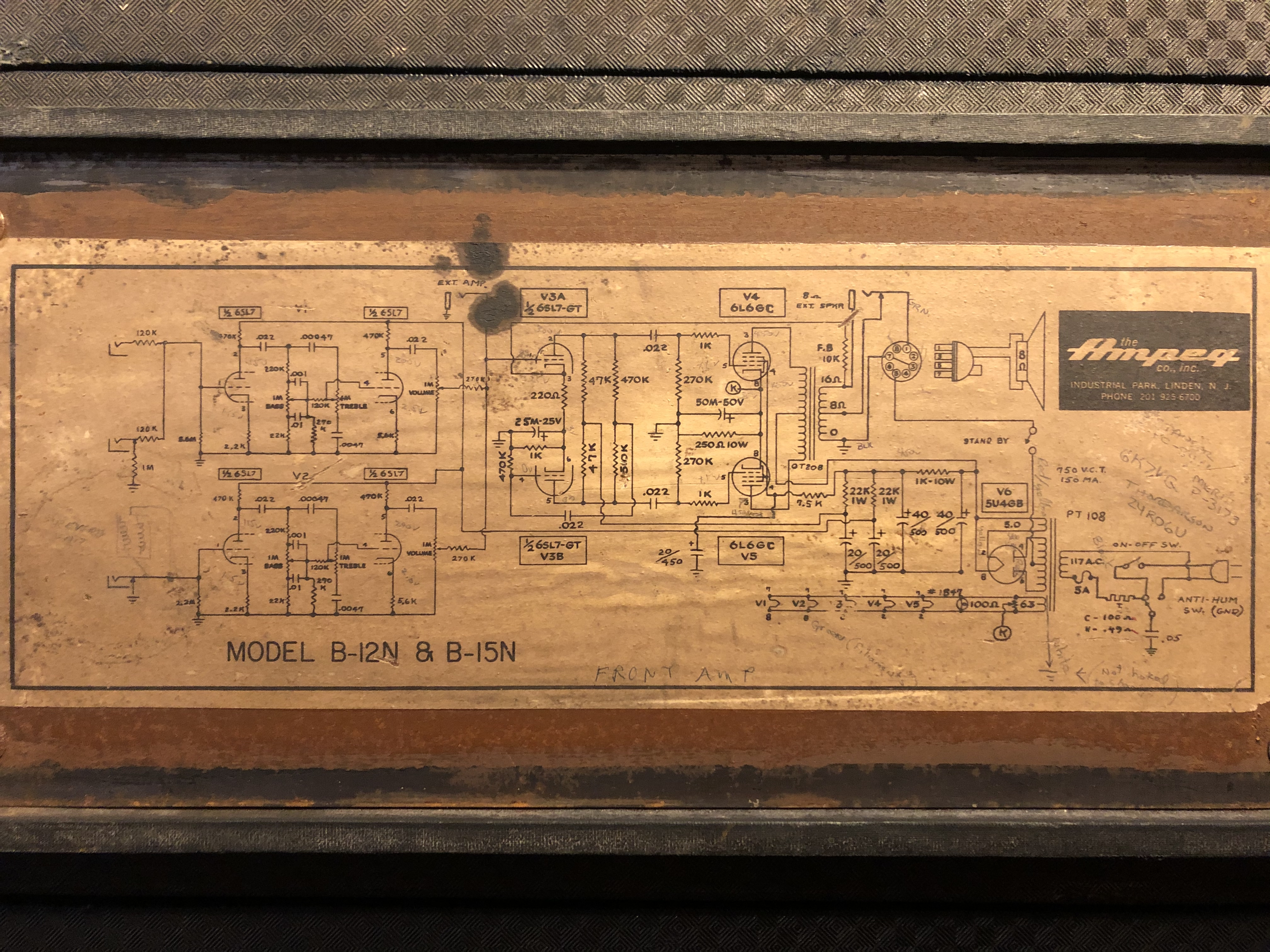Another challenge! This is my another oldie that I brought from the attic today and want to bring it back to the playing condition. Still learning those amps, constructions, schematics!  It's an early 1963 model, cathode biased. Cabinet has factory upgrade Altec. it has 5U4 rectifier instead of later 5AR4.
It's an early 1963 model, cathode biased. Cabinet has factory upgrade Altec. it has 5U4 rectifier instead of later 5AR4.
Its blowing fuses just after powered.
1. I have ordered some caps (40+40+40+40), new power tubes (actual ones have 50-60% emission). Preamp tubes are OK and I already have NOS 5U4GB Sylvania.
2. I have cleaned some mess inside, cut the 0.5uf death cap and all the connections to polarity switch (it would be there only for cosmetical reasons)
3. I have cut 2-prong power cut to fit later new grounded one, I will make solid ground in the transformer base
4. I have cut the original octal "tube" speaker cable (was just dissolving in hands...) also I changed the jack input in the cabinet leaving original housing.
5. I have cut some strange 2x 50ohm resistors that were wired with two sets of diodes to the pin6 and pin8 of the recitfier (???) I have read something about it, but want to leave it like in the factory (photo)
Now, I have some questions.
1. I want to add spekaer input jack on the back of the chassis using the existing hole from the original speaker cable. And here are the questions. Should I make it with washers from both sides like the EXT. SPKR jack that is nearby? (I did that as you seen on the pic but want to make sure). I also have inside 3 wires cut from old speaker cable, RED, WHITE and BLACK (pictured), so I assume I connect black to ground of the new main output jack, then jumper (+) to the (+) of the nearby EXT SPKR jack, right? That leaves the red and white unused - were they for the standby switch "protection" and can be just desoldered all the way? Do I need to put another black grounding to the jack somewhere (saw some shots like that - two black wires coming from the (-) of the main jack spkr out.
2. Why one of the power cables that run from the on/off switch goes throught 100ohm resistor? (first one from the side of the chassis, black "circle" type) What should be the proper connection without death cap and with the fuse holde (polarity switch completely off)?
3. Still wondering what is the cause of blowing fuses. Maybe I should check transformers? What is the procedure? I have never done that but It would be nice to know something more!
Thank you!




Its blowing fuses just after powered.
1. I have ordered some caps (40+40+40+40), new power tubes (actual ones have 50-60% emission). Preamp tubes are OK and I already have NOS 5U4GB Sylvania.
2. I have cleaned some mess inside, cut the 0.5uf death cap and all the connections to polarity switch (it would be there only for cosmetical reasons)
3. I have cut 2-prong power cut to fit later new grounded one, I will make solid ground in the transformer base
4. I have cut the original octal "tube" speaker cable (was just dissolving in hands...) also I changed the jack input in the cabinet leaving original housing.
5. I have cut some strange 2x 50ohm resistors that were wired with two sets of diodes to the pin6 and pin8 of the recitfier (???) I have read something about it, but want to leave it like in the factory (photo)
Now, I have some questions.
1. I want to add spekaer input jack on the back of the chassis using the existing hole from the original speaker cable. And here are the questions. Should I make it with washers from both sides like the EXT. SPKR jack that is nearby? (I did that as you seen on the pic but want to make sure). I also have inside 3 wires cut from old speaker cable, RED, WHITE and BLACK (pictured), so I assume I connect black to ground of the new main output jack, then jumper (+) to the (+) of the nearby EXT SPKR jack, right? That leaves the red and white unused - were they for the standby switch "protection" and can be just desoldered all the way? Do I need to put another black grounding to the jack somewhere (saw some shots like that - two black wires coming from the (-) of the main jack spkr out.
2. Why one of the power cables that run from the on/off switch goes throught 100ohm resistor? (first one from the side of the chassis, black "circle" type) What should be the proper connection without death cap and with the fuse holde (polarity switch completely off)?
3. Still wondering what is the cause of blowing fuses. Maybe I should check transformers? What is the procedure? I have never done that but It would be nice to know something more!
Thank you!

Comment